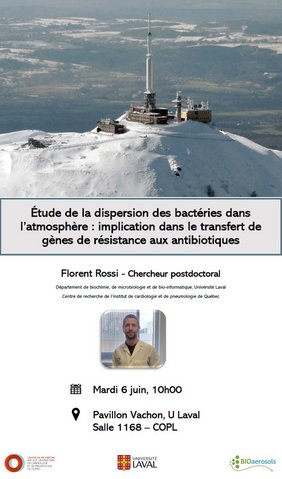Lecture by Florent Rossi
Click here to view the conference recording (In French)
Tuesday, June 6 at 10:00 a.m.
Vachon Building, room 1168-COPL
The Earth's atmosphere constantly receives large quantities of biological origin material, also known as bioaerosols, emitted from the surface (soil, water, phyllosphere, etc.) by mechanical disturbances such as wind essentially. In this way, between 7.6 × 1023 and 3.5 × 1024 bacteria could be emitted each year (Burrows et al., 2009), transported thousands of kilometers from their sources of emission by air, and reach the upper atmosphere. However, the conditions encountered during atmospheric transit (low temperatures, UV, desiccation, oxidative stress, etc.) strongly constrain microbial viability and activity. However, recent studies tend to show the existence of an adapted atmospheric microbiota that is quite distinct from the sources (Šantl-Temkiv et al., 2022). The activation of specific genes after aerosolization, including some antibiotic resistance genes (Smith and King, 2022), seems to testify to the selective aspect imposed by the atmosphere on the bacteria passing through it. Furthermore, the expression of metabolic pathways involved in stress response (osmotic, oxidative) and energy acquisition (central metabolism), particularly in cloud-derived bacterial communities (Amato et al., 2019), suggest a more favorable environment for aerial survival, mediated by the presence of water in the form of microdroplets. Thus, the atmosphere, via clouds, would be a potentially important vector of bacteria on a planetary scale, carrying with them genetic material such as antibiotic resistance genes (ARGs). Understanding these flows and identifying the meteorological parameters likely to influence them would thus shed light on the atmospheric contribution to the spread of antibiotic resistance.

